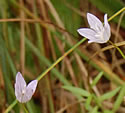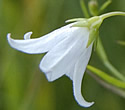Campanula aparinoides (Marsh Bellflower)
| Also known as: | Bedstraw Bellflower |
|---|---|
| Genus: | Campanula |
| Family: | Campanulaceae (Bellflower) |
| Life cycle: | perennial |
| Origin: | native |
| Habitat: | part shade, sun; wet meadows, swamps, along shores |
| Bloom season: | June - August |
| Plant height: | 6 to 36 inches |
| Wetland Indicator Status: | GP: OBL MW: OBL NCNE: OBL |
| MN county distribution (click map to enlarge): |  |
| National distribution (click map to enlarge): |  |
Pick an image for a larger view. See the glossary for icon descriptions.
Detailed Information
Flower: 

![[photo of flower]](/udata/r9ndp23q/pd/campanula-aparinoides-009-t.jpg) Flowers are solitary, sometimes nodding, on long slender stalks at the end of branching stems. Flowers are ¼ to ½ inch long, white or pale blue with 5 flaring petals pointed at the tip and fused near the base, creamy white stamens, and a long divided style curled at the tips. The petals are veined with pale blue to grayish white.
Flowers are solitary, sometimes nodding, on long slender stalks at the end of branching stems. Flowers are ¼ to ½ inch long, white or pale blue with 5 flaring petals pointed at the tip and fused near the base, creamy white stamens, and a long divided style curled at the tips. The petals are veined with pale blue to grayish white.
Leaves and stem: 

![[photo of var. aparinoides leaves]](/udata/r9ndp23q/white/marsh-bellflower-100_9786-t.jpg) Leaves have tiny, often widely spaced teeth around the edges, pointed tips, are slightly rough around the edges and along the midrib on the underside from tiny hooked hairs, and have little or no leaf stalk. Leaves of var. aparinoides are to 1½ inches long and ¼ inch wide, or about 6 times as long as wide.
Leaves have tiny, often widely spaced teeth around the edges, pointed tips, are slightly rough around the edges and along the midrib on the underside from tiny hooked hairs, and have little or no leaf stalk. Leaves of var. aparinoides are to 1½ inches long and ¼ inch wide, or about 6 times as long as wide.
![[photo of var. grandiflora leaves]](/udata/r9ndp23q/pd/campanula-aparinoides-007-t.jpg) Leaves of var. grandiflora are up to 2½ inches long and more linear, to 12 times as long as wide. Stems are weak, 3 sided with hooked hairs that grab onto surrounding vegetation and help support the plant.
Leaves of var. grandiflora are up to 2½ inches long and more linear, to 12 times as long as wide. Stems are weak, 3 sided with hooked hairs that grab onto surrounding vegetation and help support the plant.
Fruit: 
![[photo of fruit]](/udata/r9ndp23q/white/marsh-bellflower_0831_114110-t.jpg) Fruit is a globular, ribbed capsule about 1/6 inch long with 3 sections.
Fruit is a globular, ribbed capsule about 1/6 inch long with 3 sections.
Notes:
Minnesota has 2 varieties of Marsh Bellflower, var. aparinoides and var. grandiflora (formerly known as Campanula uliginosa) but the Herbarium records do not always distinguish them. The flowers are much the same between the 2, though the latter is minutely larger; the primary difference is the leaves as described above. Due to its weak stems, Marsh Bellflower typically sprawls along the ground and tangles itself up in neighboring plants.Native Plant Nurseries, Restoration and Landscaping Services ↓
More photos
Photos by K. Chayka taken in Ramsey and Anoka counties. Photos courtesy Peter M. Dziuk taken in Anoka county.
Comments
Have you seen this plant in Minnesota, or have any other comments about it?
on: 2015-07-27 22:06:46
Marsh bellflower var. grandiflora was growing near Tamarac Lake, south access. Easy to overlook amidst coarser vegetation!
on: 2015-08-22 09:15:58
August 8, 2015 on guided tour of area
on: 2016-08-03 16:34:37
I found some today, Aug. 3 on our Lund Lake, a small marshy lake. I checked in two flower i.d. books, but couldn't find it. I will check your Website from now on! I love it! Thanks!
on: 2022-07-17 14:08:43
Found along shore of lake. This lake is not far from Tamarac NWR.
on: 2023-07-18 11:37:30
Found masses of these growing amongst fine leaved sedges in a swampy area near Sundew Pond.







 Marsh Bellflower plants
Marsh Bellflower plants a tangle of plants
a tangle of plants more flowers
more flowers